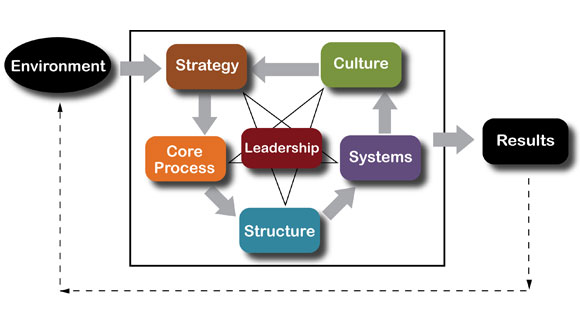The Transformation Model is the framework we use to help leaders understand their organizations and also guide a successful redesign. The model reduces the complexity of an organization to eight key variables that must be understood and aligned for a business to be successful. Alignment implies a holistic or systems point of view that finds the best “fit” between all organizational elements. Paying attention to and understanding these variables will result in major improvements in customer service, quality, efficiency, cycle time, profitability and satisfaction of employees.

These eight variables form the “big picture” or context of an organization and ultimately determine its success. When we talk about organization design we are talking about the relationship and balance between each of these variables. The role of leaders could be defined as understanding and managing these variables.
Environment. Organizations, like all living systems, can survive only to the extent that they maintain harmony with their external environment. This includes being sensitive to the evolving needs and perceptions of customers, understanding changes occurring in technologies, knowing your competition and understanding the legal, social and political climates. Most organizations eventually die because they fail to maintain a responsive attitude towards their environment.
Strategy. There are two parts to strategy. Business strategy is a set of conscious decisions about how the organization will add value to customers and distinguish itself from its competitors. It also includes performance targets and strategy for growth. A well developed business strategy tells the organization where it is going and guides it like a ships rudder in a stormy sea. An Organization strategy is the “being” or character of the organization. It has to do with who we are and not just what we do. It includes the mission, vision of the future, values and guiding principles. A clear organizational strategy helps transform a company or office from a normal work place to one that inspires people and brings out their best.
Core Process. This is the flow of work through the organization. It is the sequence of events or steps necessary to get a product out the door or deliver a service. This also includes the technology and resources (equipment, software, space and materials) required to produce a deliverable. Core business processes are, or should be, the focal point around which all other business unit activity is organized. Understanding, streamlining and properly supporting core business processes is the central job of any organization.
Structure. How people are organized around business processes. It moves beyond box charts to understanding the boundaries, roles, responsibilities and reporting relationships among people. It is a sort of template that determines not only relationships but coordination of tasks and allocation of resources around business processes. The proper question about structure is not whether it is the right one, but whether it fits with the rest of the organization (core process, strategy) and helps rather than hinders performance.
Systems. Systems are the inter-related sets of tasks or activities that help organize and coordinate work. Examples include recruiting and selection, training and development, how people are promoted, communication/ information sharing, decision making, how people are rewarded, planning/ goal setting, personnel policies and procedures, performance feedback, etc. Systems are usually standardized and cut across the whole organization. They are often “owned” by management or special support functions. The most effective systems are often the simplest.
Culture. Culture is how the organization really operates. It consists of the leadership style, worker attitudes and habits and management practices that make up the distinctive “personality” of the organization. It is like the air that permeates everything and is both cause and effect of organization behavior. Culture mirrors the true philosophy and values that the organization actually practices. As such, it is a measure of how well an organization has translated its philosophy (organizational strategy) into practice.
Results. What is the organization’s current performance? Results define the success or health of an organization and are therefore the starting point for understanding how well the organization is functioning. Results indicate where the organization is strong and what it needs to keep doing, as well as where it is weak and what it needs to change. Everything is tied to results. Not being clear about current or future results is like being lost at sea; even knowing where you want to go, you don’t know how to get there.
Leadership. Leaders drive success. They set goals and monitor results, scan the external environment, define vision and strategy, design (consciously or by default) the infrastructure of the organization, develop people and build culture. However, traditional assumptions, roles and practices of leadership are no longer adequate to manage in today’s complex world. Successful leaders are changing their assumptions about work, organizations and people to build collaborative, more responsive organizations.